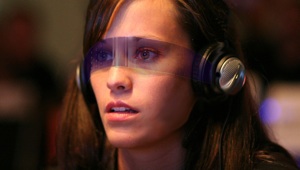A magazine where the digital world meets the real world.
On the web
- Home
- Browse by date
- Browse by topic
- Enter the maze
- Follow our blog
- Follow us on Twitter
- Resources for teachers
- Subscribe
In print
What is cs4fn?
- About us
- Contact us
- Partners
- Privacy and cookies
- Copyright and contributions
- Links to other fun sites
- Complete our questionnaire, give us feedback
Search:
Reality? We can do better than that

Have a look around you. As your vision wanders over objects, people and places, how do you know what or who they are? You depend on the information in your memory. Well that’ll just never do. What happens if you’re lost in a strange city? Or looking at something you want to find out more about? In boring old reality, you’d need a map, or maybe a travel guide app for your phone. But in augmented reality, the answer could be right in front of you.
You’ve probably seen augmented reality before, just not in real life. Have you ever watched a movie where a cyborg can simply glance at someone, and up will pop their name, who they work for, and the word DESTROY? That’s augmented reality. It blends a normal view of the world with computerised tags containing extra information. Like many of today’s gadgets it only used to exist in films and computer games, but in the next couple of years you’ll see it more and more in the real world.
The signs are all around you
The uses for augmented reality in everyday life won’t be quite so much about blowing things up as they are in films. It’s more about adding information to what you already see. For example, a UK company called Acrossair will soon release an application called Nearest Tube for the iPhone that would help people in London find their nearest tube station. All the user has to do is point the camera at their surroundings. The iPhone’s GPS figures out the phone’s location and the direction it’s pointing, which it compares to the locations of the closest stations.
Here’s where augmented reality comes in. Instead of displaying a map or directions to the station, the user just holds up the phone and looks at the screen. Nearest Tube uses the iPhone’s camera to see what the user is pointing at, and then it adds labels to the scene that show what direction the station is in. It’s as if someone’s hung a sign in mid-air. Then if the user points the phone at the ground, they see arrows pointing in the direction they should walk.
Helpful holograms
The future of augmented reality promises a lot more. One day you may not have to look on a screen to see additions to the world around you – holograms could do the job instead. Holographic arrows on the ground might point you towards the tube. If you wanted to write an email, a keyboard could hover in front of you. Then once you’ve sent your message, why not relax for a few minutes by turning the keyboard into a virtual air hockey table?
It gets even better. Researchers at the University of Tokyo have made a prototype of a system that uses ultrasound to generate force. They want to add it to holographic systems so you can feel as though you’re actually touching the object you see in front of you.
It’s likely to be a long time before you’ll spend your days surrounded by holograms, but the release of augmented reality programs for phones is happening right now. You won’t have to wait long before you can access all sorts of extra information about what’s around you. Thank goodness, because plain old reality can sometimes use some spicing up.


